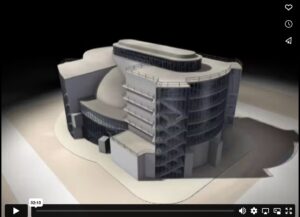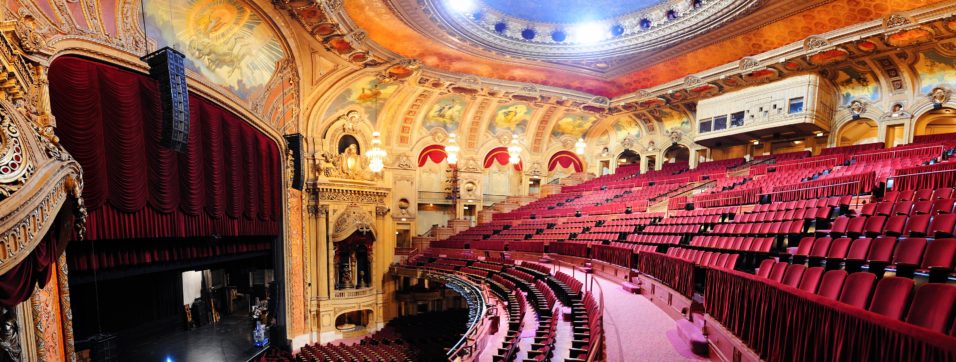Chicago Theatre interior, 2011 © Can Stock Photo / rabbit75can
This section is currently being developed. Please bear with us while we add content.
Anatomy of a Theatre – the different parts of a theatre building
Actor/Audience Relationships
Although ‘end-on’ or proscenium stage layout is the most common relationship between actors/performers and audience, there are many other possible layouts.
End-On
The audience faces a rectangular stage area. Sometimes the stage is framed by a proscenium arch, which acts as the window through which the audience sees the stage. Many older theatres have ornate decoration around the proscenium arch.
See also: Raked Stages
Thrust
Based on an end-on stage, but has additional audience seating locations with side views of the stage as well.
In-The-Round
The audience is in a series of blocks surrounding a central stage space. The stage may be circular or rectangular / square. The audience may be on the same level floor as the stage, or the stage may be raised, or the audience seating may be raked / on levels.
Arena Staging
A larger-scale version of in-the-round, where a raised platform stage is surrounded by large tiered banks of seating on all sides.
Promenade
The guided form of Promenade performance has the audience following the actors around a space / area along a fixed route. As the audience move from area to area, there as usually clear areas where the performance takes place.
A more recent form, championed by site-specific performance groups such as Punchdrunk, has the audience roaming freely around a building, where they discover intricately designed areas which may or may not contain performers. They may follow actors around, or they may remain in a particular location and watch everything that takes place there.
Parts of the Stage
See the Glossary of Technical Theatre Terms – The Theatre Building
Additional Information
Amazon Shop
Theatre Architects:
Frank Matcham (1854 – 1920)
Legendary Victorian theatre architect and designer, who is responsible for many iconic British buildings. The Frank Matcham Society celebrates his work.
- Aberdeen Tivoli Theatre (1897 auditorium remodelled)
- Blackpool Grand Theatre(1894)
- Bristol Hippodrome(1912)
- Buxton Opera House
- Everyman Theatre, Cheltenham (originally The Opera House)
- Gaiety Theatre, Isle of Man
- Grand Opera House, Belfast (1895)
- Grand Theatre, Blackpool
- Hackney Empire
- Kings Theatre Southsea (1907)
- London Coliseum
- London Hippodrome
- London Palladium
- Lyric Hammersmith
- Sadlers Wells Theatre
- Shepherd’s Bush Empire
- Theatre Royal Wakefield (1894)
- Victoria Palace
W & T.R.Milburn
William Milburn (1858 – 1935) and Thomas Ridley Milburn (1861 – 1943) became the premier theatre architectural firm in the north of England.
- Olympia, Newcastle upon Tyne (1893, Thomas Milburn, in association with Thomas Oliver & Leeson)
- Empire Palace, South Shields (1896-7, for Moss Empires, with Frank Matcham as consultant)
- Empire, Sunderland (1906)
- Union Mill, Montrose Angus, Scotland (1921)
- Coliseum Theatre Glasgow, Scotland (1922)
- Empire Palace Theatre, Edinburgh, Scotland (1927 – rebuilding of Matcham’s theatre)
- Empire Theatre, Glasgow, Scotland (1928 – internal rebuilding of Matcham’s theatre on a larger scale & alterations to the exterior)
- Empire, Southampton (1929)
- Empire Palace, South Shields (1929, major alterations)
- Empire, Glasgow (1931?1928? alterations)
- New (Apollo) Theatre, Oxford (1933, with T P Bennett)
More about the Milburn practice.
W.G.R.Sprague
William George Robert Sprague (1863 – 1933) Theatre architect.
More about Sprague at the Arthur Lloyd website
- Aldwych Theatre and Novello Theatre
- Ambassadors Theatre and St Martins Theatre
- Sondheim Theatre (formerly Queens Theatre) and Gielgud Theatre
- Streatham Hill Theatre
- Wyndhams Theatre
Walter Gropius
Developed a concept for the Total Theater for Erwin Piscator in 1926, which was not able to be practically realised in his lifetime. Some of the groundbreaking ideas were incorporated into the design of the New London Theatre which opened in 1973.

Walter Gropius Total Theatre 3d Visualization. from Javier Nuñez on Vimeo.
Suppliers |
| Gala Systems |
| Theatre Projects Design [UK, USA, France, China] |
Keywords: stage types theatres, theatre in round, types spaces, types of stages, types of theatres, stage layout types, parts of the stage








